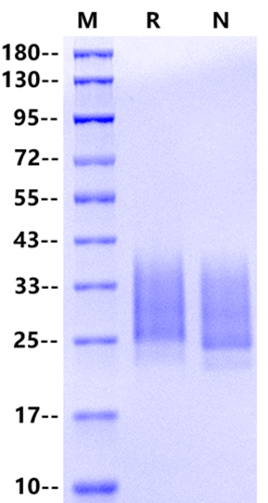Tyr26-Lys190, with N-terminal 9*His HHHHHHHHHDDDDKYFPQVFGKSNDGFVPTESYGTTSVQNVSQIFGRNDESTMPTRSYGTVCPRNWDFHQGKCFFFSFSESPWKDSMDYCATQGSTLAIVNTPEKLKYLQDIAGIENYFIGLVRQPGEKKWRWINNSVFNGNVTNQDQNFDCVTIGLTKTYDAASCEVSYRWICEMNAK
27-35kDa (Reducing)
>95% by SDS-PAGE
Reconstitute at 0.1-1 mg/ml according to the size in ultrapure water after rapid centrifugation.
CLEC5A is a spleen tyrosine kinase (Syk)-coupled C-type lectin that is highly expressed by monocytes, macrophages, neutrophils, and dendritic cells and interacts with virions directly, via terminal fucose and mannose moieties of viral glycans. CLEC5A also binds to N-acetyl glucosamine (GlcNAc) and N-acetylmuramic acid (MurNAc) disaccharides of bacterial cell walls. Compared to other C-type lectins (DC-SIGN and DC-SIGNR) and TLRs, CLEC5A binds its ligands with relatively low affinities. However, CLEC5A forms a multivalent hetero-complex with DC-SIGN and other C-type lectins upon engagement with ligands, and thereby mediates microbe-induced inflammatory responses via activation of Syk. For example, in vivo studies in mouse models have demonstrated that CLEC5A is responsible for flaviviruses-induced hemorrhagic shock and neuroinflammation, and a CLEC5A polymorphism in humans is associated with disease severity following infection with dengue virus. In addition, CLEC5A is co-activated with TLR2 by Listeria and Staphylococcus. Furthermore, CLEC5A-postive myeloid cells are responsible for Concanavilin A-induced aseptic inflammatory reactions. Thus, CLEC5A is apromis-Cuous pattern recognition receptor in myeloid cells and is a potential therapeutic target for attenuation of both septic and aseptic inflammatory reactions.
